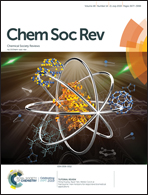Effects of in vivo conditions on amyloid aggregation
Abstract
One of the grand challenges of biophysical chemistry is to understand the principles that govern protein misfolding and aggregation, which is a highly complex process that is sensitive to initial conditions, operates on a huge range of length- and timescales, and has products that range from protein dimers to macroscopic amyloid fibrils. Aberrant aggregation is associated with more than 25 diseases, which include Alzheimer's, Parkinson's, Huntington's, and type II diabetes. Amyloid aggregation has been extensively studied in the test tube, therefore under conditions that are far from physiological relevance. Hence, there is dire need to extend these investigations to in vivo conditions where amyloid formation is affected by a myriad of biochemical interactions. As a hallmark of neurodegenerative diseases, these interactions need to be understood in detail to develop novel therapeutic interventions, as millions of people globally suffer from neurodegenerative disorders and type II diabetes. The aim of this review is to document the progress in the research on amyloid formation from a physicochemical perspective with a special focus on the physiological factors influencing the aggregation of the amyloid-β peptide, the islet amyloid polypeptide, α-synuclein, and the hungingtin protein.



 Please wait while we load your content...
Please wait while we load your content...